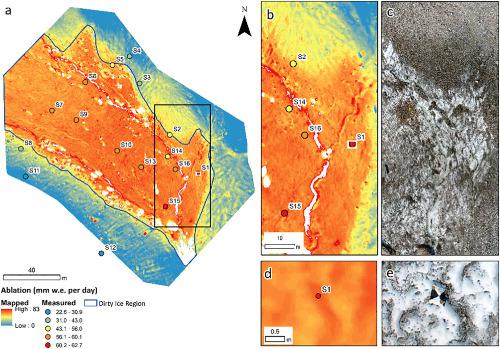当前位置:
X-MOL 学术
›
Earth Surf.Process. Land.
›
论文详情
Our official English website, www.x-mol.net, welcomes your feedback! (Note: you will need to create a separate account there.)
Processes at the margins of supraglacial debris cover: Quantifying dirty ice ablation and debris redistribution
Earth Surface Processes and Landforms ( IF 3.3 ) Pub Date : 2020-06-18 , DOI: 10.1002/esp.4879 Catriona L. Fyffe 1 , Amy S. Woodget 2 , Martin P. Kirkbride 3 , Philip Deline 4 , Matthew J. Westoby 1 , Ben W. Brock 1
Earth Surface Processes and Landforms ( IF 3.3 ) Pub Date : 2020-06-18 , DOI: 10.1002/esp.4879 Catriona L. Fyffe 1 , Amy S. Woodget 2 , Martin P. Kirkbride 3 , Philip Deline 4 , Matthew J. Westoby 1 , Ben W. Brock 1
Affiliation

|
Current glacier ablation models have difficulty simulating the high‐melt transition zone between clean and debris‐covered ice. In this zone, thin debris cover is thought to increase ablation compared to clean ice, but often this cover is patchy rather than continuous. There is a need to understand ablation and debris dynamics in this transition zone to improve the accuracy of ablation models and the predictions of future debris cover extent. To quantify the ablation of partially debris‐covered ice (or ‘dirty ice’), a high‐resolution, spatially continuous ablation map was created from repeat unmanned aerial systems surveys, corrected for glacier flow in a novel way using on‐glacier ablation stakes. Surprisingly, ablation is similar (range ~5 mm w.e. per day) across a wide range of percentage debris covers (~30–80%) due to the opposing effects of a positive correlation between percentage debris cover and clast size, countered by a negative correlation with albedo. Once debris cover becomes continuous, ablation is significantly reduced (by 61.6% compared to a partial debris cover), and there is some evidence that the cleanest ice (<~15% debris cover) has a lower ablation than dirty ice (by 3.7%). High‐resolution feature tracking of clast movement revealed a strong modal clast velocity where debris was continuous, indicating that debris moves by creep down moraine slopes, in turn promoting debris cover growth at the slope toe. However, not all slope margins gain debris due to the removal of clasts by supraglacial streams. Clast velocities in the dirty ice area were twice as fast as clasts within the continuously debris‐covered area, as clasts moved by sliding off their boulder tables. These new quantitative insights into the interplay between debris cover characteristics and ablation can be used to improve the treatment of dirty ice in ablation models, in turn improving estimates of glacial meltwater production. © 2020 The Authors. Earth Surface Processes and Landforms published by John Wiley & Sons Ltd
中文翻译:

冰川上碎片覆盖边缘的过程:量化脏冰消融和碎片重新分布
当前的冰川消融模型很难模拟干净的冰和碎屑覆盖的冰之间的高熔点过渡带。在该区域中,较薄的碎屑覆盖层被认为比干净的冰块增加了消融,但通常这种覆盖层是不完整的而不是连续的。有必要了解该过渡区中的烧蚀和碎屑动力学,以提高烧蚀模型的准确性以及对未来碎屑覆盖范围的预测。为了量化部分被碎片覆盖的冰(或“脏冰”)的消融,通过重复的无人航空系统勘测创建了高分辨率,空间连续的消融图,并使用冰川消融桩以新颖的方式对冰川流进行了校正。 。令人惊讶的是,在很大范围的碎片覆盖范围内,消融是相似的(每天约5毫米)。〜 30-80%),由于百分比碎片盖和碎屑尺寸之间的正相关性,通过与反照率呈负相关反驳的相对影响。一旦碎片覆盖物变得连续,消融就会大大减少(与部分碎片覆盖物相比减少了61.6%),并且有证据表明最干净的冰块(< 〜15%的碎片覆盖率)比脏冰的消融率低(降低了3.7%)。对碎片运动的高分辨率特征跟踪显示了碎片连续的强模式碎片速度,表明碎片通过冰m斜坡向下蠕动而运动,从而促进了碎片在坡脚趾处的生长。但是,并非所有的斜坡边缘都会因碎屑流被碎屑流清除而获得碎屑。脏冰区域中的碎石速度是不断被碎屑覆盖的区域中碎石的速度的两倍,这是碎石滑落其巨石台而移动的速度的两倍。这些关于碎片覆盖特征与消融之间相互作用的新的定量见解可用于改善消融模型中对脏冰的处理,进而改善冰川融水产量的估算。©2020作者。
更新日期:2020-06-18
中文翻译:

冰川上碎片覆盖边缘的过程:量化脏冰消融和碎片重新分布
当前的冰川消融模型很难模拟干净的冰和碎屑覆盖的冰之间的高熔点过渡带。在该区域中,较薄的碎屑覆盖层被认为比干净的冰块增加了消融,但通常这种覆盖层是不完整的而不是连续的。有必要了解该过渡区中的烧蚀和碎屑动力学,以提高烧蚀模型的准确性以及对未来碎屑覆盖范围的预测。为了量化部分被碎片覆盖的冰(或“脏冰”)的消融,通过重复的无人航空系统勘测创建了高分辨率,空间连续的消融图,并使用冰川消融桩以新颖的方式对冰川流进行了校正。 。令人惊讶的是,在很大范围的碎片覆盖范围内,消融是相似的(每天约5毫米)。〜 30-80%),由于百分比碎片盖和碎屑尺寸之间的正相关性,通过与反照率呈负相关反驳的相对影响。一旦碎片覆盖物变得连续,消融就会大大减少(与部分碎片覆盖物相比减少了61.6%),并且有证据表明最干净的冰块(< 〜15%的碎片覆盖率)比脏冰的消融率低(降低了3.7%)。对碎片运动的高分辨率特征跟踪显示了碎片连续的强模式碎片速度,表明碎片通过冰m斜坡向下蠕动而运动,从而促进了碎片在坡脚趾处的生长。但是,并非所有的斜坡边缘都会因碎屑流被碎屑流清除而获得碎屑。脏冰区域中的碎石速度是不断被碎屑覆盖的区域中碎石的速度的两倍,这是碎石滑落其巨石台而移动的速度的两倍。这些关于碎片覆盖特征与消融之间相互作用的新的定量见解可用于改善消融模型中对脏冰的处理,进而改善冰川融水产量的估算。©2020作者。


























 京公网安备 11010802027423号
京公网安备 11010802027423号